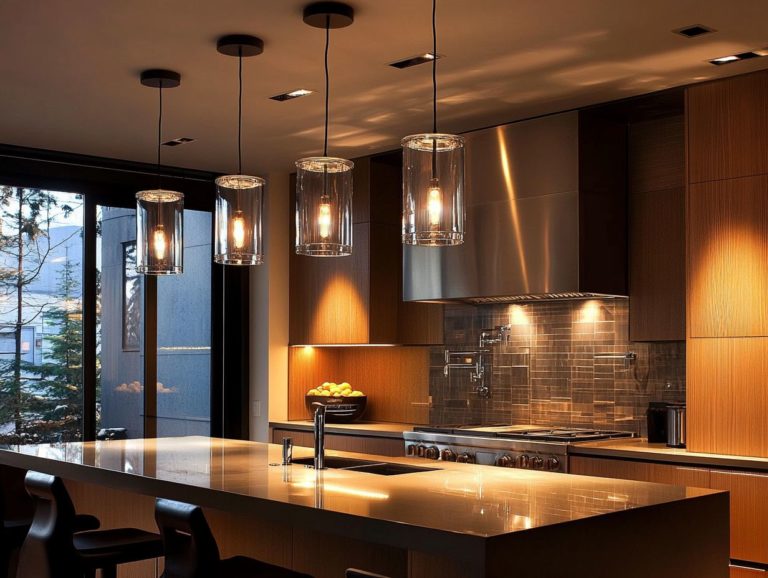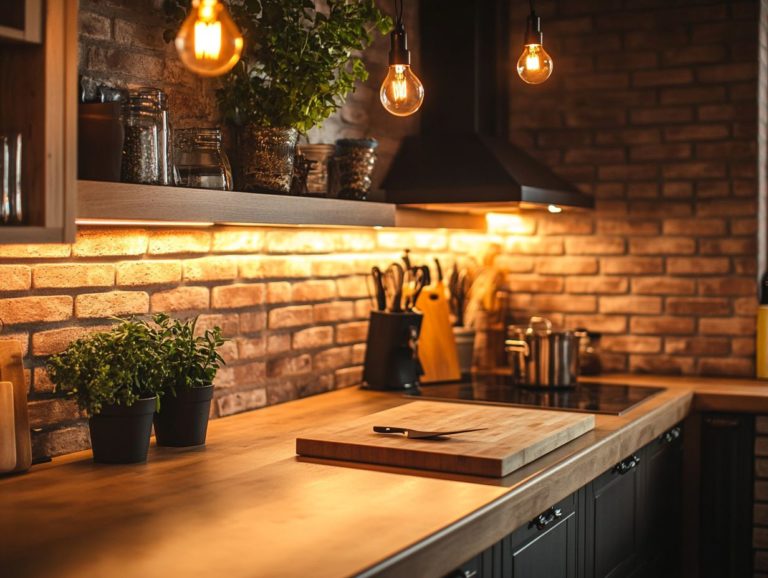Accent Lighting: Enhancing Kitchen Aesthetics
Contents
Accent Lighting in Kitchen Design
Accent lighting serves as a transformative element in your kitchen design, enhancing both functionality and style. This type of lighting creates striking focal points and highlights unique design features, effortlessly turning an ordinary kitchen into a captivating space.
You’ll discover various types of accent lighting, from under-cabinet to pendant options, along with essential considerations for selecting the perfect fixtures. Find valuable tips on installation and maintenance to ensure your kitchen remains a radiant oasis.
Get ready to elevate your kitchen’s ambiance like never before!
Key Takeaways:

Accent lighting can create a focal point in the kitchen, drawing attention to specific areas and enhancing the overall aesthetic of the space. Popular types include under-cabinet, pendant, and track lighting, which highlight design features and add depth to the kitchen.
When selecting accent lighting, consider factors such as layout, size, color scheme, and style to ensure a cohesive and functional design.
The Role of Accent Lighting in Kitchen Design
Accent lighting is essential in kitchen design, enhancing the visual allure of various aesthetics while crafting an inviting atmosphere that sparks culinary creativity.
You can explore different lighting techniques to highlight specific areas, ensuring your kitchen lighting serves its functional purpose while elevating your style.
By thoughtfully integrating accent lighting, you transform your kitchen into a warm and vibrant space, fostering an enjoyable culinary experience while embracing energy-efficient modern solutions.
What is Accent Lighting?
Accent lighting is a specialized form of lighting designed to showcase specific areas or features within your space. In kitchen lighting design, it enhances both ambiance and functionality, transforming ordinary moments into extraordinary experiences.
This type of lighting is crucial for creating the atmosphere you desire, drawing attention to elements like artwork, cabinetry, or architectural details that might otherwise remain in the shadows.
While ambient lighting provides general illumination and sets the overall mood, and task lighting focuses on specific activities like cooking or reading, accent lighting serves a distinct purpose by adding visual interest.
Consider the impact of strategically placing under-cabinet lights to beautifully illuminate your countertops, or how pendant lights over an island can become stunning focal points.
Each lighting type works harmoniously to enhance not just the aesthetics of your kitchen, but also its overall usability, ensuring every detail shines just as it should.
Creating a Focal Point
Creating a focal point in your kitchen with accent lighting means strategically positioning fixtures like pendant lights to draw attention to key features and elevate the overall aesthetic of the space. This thoughtful arrangement enhances visual appeal and adds depth and character.
When illuminating islands, for example, consider using a cluster of fixtures that emit a warm glow, inviting gatherings and enhancing meal preparation. Wall-mounted sconces can beautifully accentuate artwork or architectural details, creating dramatic shadows and highlights that breathe life into the room.
Experiment with different heights and angles to discover the most flattering and functional configuration. By emphasizing these focal points, you cultivate a dynamic atmosphere that transforms your culinary experience, making cooking and entertaining all the more engaging.
Discover the best accent lighting for your kitchen today!
Highlighting Design Features
Accent lighting is essential for showcasing design features in your kitchen. It elevates both aesthetics and functionality. You can transform the ambiance and visual appeal of the space.
Strategically place recessed lighting in the ceilings to create a gentle glow over crown molding. This becomes a stunning focal point without overwhelming the entire room.
Under-cabinet lighting is a great option, illuminating your countertops and drawing attention to exquisite cabinetry and decorative items that might otherwise go unnoticed. This enhances the overall design and boosts visibility for cooking, making it a smart investment for any culinary enthusiast.
By weaving in these subtle yet impactful lighting elements, you can craft a kitchen that feels stylish and inviting.
Types of Accent Lighting

When you think about accent lighting in your kitchen, explore different fixtures that enhance both functionality and aesthetics.
Embrace modern trends, like LED lights and smart lighting solutions, to transform your space into a sophisticated haven.
Under Cabinet Lighting
Under-cabinet lighting is a top choice for accent lighting, offering practical task illumination and a visually appealing ambiance.
This option brightens your workspaces, making food prep and cleanup more efficient around the sink and countertops.
Strategically place light fixtures beneath your cabinetry to reduce shadows, especially during evening meal prep.
If you’re considering installation, choose LED strips or puck lights. They are energy-efficient and require minimal tools for setup.
These lights also add a sophisticated touch to your kitchen’s aesthetics, making the space feel modern and inviting.
Pendant Lighting
Pendant lights are an exquisite option for accent lighting in your kitchen, blending style and functionality seamlessly.
Place these fixtures over islands or dining areas to illuminate the space and create stunning focal points that draw the eye.
With designs ranging from sleek modern to classic rustic, pendant lights harmonize beautifully with ambient lighting, like recessed lights or under-cabinet fixtures.
Imagine colorful glass pendants bringing vibrant energy to the room, while brushed metal finishes add elegance to an industrial-themed kitchen.
This thoughtful integration of lighting elements establishes the desired mood and enhances your culinary experience.
Track Lighting
Track lighting is a sophisticated way to accentuate your kitchen. It offers flexibility to direct light where you want and highlight specific design features.
This adaptability makes it ideal for kitchens of all styles, whether you prefer a sleek modern look or a touch of rustic charm.
Adjust the track heads to illuminate countertops, highlight the stove area, or showcase decorative shelving and artwork.
When selecting a track lighting system, consider the kitchen size and overall design theme.
Dimmable fixtures enhance ambiance, creating a cozy atmosphere during meals while ensuring bright functionality during food preparation.
For the best results, ensure proper installation with secure mounting and strategic positioning to maximize coverage and minimize unwanted shadows.
Factors to Consider when Choosing Accent Lighting
When choosing accent lighting for your kitchen, consider several key factors.
Account for the layout, size, color scheme, and overall design style of the space. This will help you create a cohesive and inviting atmosphere that enhances both functionality and aesthetics.
Transform your kitchen now by exploring these stunning lighting options! Don’t miss out on elevating your space!
Kitchen Layout and Size

The layout and size of your kitchen play an important role in selecting the right accent lighting. This dictates both the type and number of fixtures that can be seamlessly integrated into the space.
For example, if you have an open-concept kitchen, ambient lighting that flows effortlessly into adjacent living areas is a fantastic choice. On the other hand, a closed kitchen might require brighter task lighting to effectively illuminate your workspaces.
Proportional lighting is key. A spacious kitchen often requires larger fixtures and multiple light sources to adequately fill the expansive area without leaving dark corners lurking. Conversely, in a compact kitchen, the focus should be on maximizing brightness with fewer, strategically placed fixtures.
Utilizing under-cabinet lights and stylish pendant fixtures can elevate the design in smaller spaces, creating an open and inviting atmosphere while ensuring the light remains harmonious and not overwhelming.
Color Scheme and Style
The color scheme and style of your kitchen play a crucial role in selecting the best options for accent lighting. They should not only harmonize with the overall design but also enhance the kitchen’s aesthetics.
If you have a modern kitchen with a monochromatic theme, sleek, geometric pendant lights could punctuate the space beautifully. They achieve this without overwhelming it.
On the other hand, a warm, farmhouse-inspired kitchen might shine with vintage-style Edison bulbs that bring a sense of charm and coziness.
It’s important to consider how different color palettes influence your lighting choices. Cooler tones can amplify a bright, crisp feel, while warmer hues foster a more inviting atmosphere.
By maintaining a cohesive look with your accent lighting, you not only highlight specific areas or features but also ensure that the overall illumination flows seamlessly, unifying your kitchen’s design and making it visually stunning.
Installation and Maintenance of Accent Lighting
Proper installation and maintenance of accent lighting are essential for optimizing both performance and aesthetics in your kitchen.
Attention to detail enhances the visual appeal and ensures the longevity and functionality of your chosen lighting fixtures.
By prioritizing these aspects, you create an inviting atmosphere.
DIY vs Professional Installation
Choosing between a DIY approach and professional installation for accent lighting in your kitchen hinges on the complexity of your design and your own experience with lighting projects.
It’s essential to weigh factors like your budget, the time you’re willing to invest, and the aesthetic you’re aiming to achieve.
If you’re looking at simple tasks, such as adding under-cabinet lights or swapping out existing fixtures, a DIY route can be both fulfilling and budget-friendly. However, if your vision involves intricate designs that require wiring or significant modifications, consider hiring a professional to get it done right and keep it safe.
For those who decide to go the DIY path, meticulous planning is vital. Selecting high-quality materials and consulting tutorials or seeking advice from professionals when necessary can significantly enhance your chances of a successful outcome.
Tips for Proper Maintenance
- Proper maintenance of accent lighting is essential for ensuring its longevity and optimal performance, allowing you to enjoy the ambiance and functionality of your kitchen for years to come.
- Making regular checks and upkeep a priority can prevent potential issues and enhance the brightness of your fixtures.
- It’s a good idea to clean your light fixtures routinely, as dust and grime can dull their shine and even lead to overheating.
- When the time comes for bulb replacement, opting for energy-efficient options not only reduces your electricity bills but also extends the lifespan of your fixtures.
- Periodically inspecting wiring and connections ensures everything operates smoothly, giving you peace of mind and a consistently inviting environment.
Frequently Asked Questions

Here are some common questions regarding accent lighting and its installation:
What is Accent Lighting?
Accent lighting highlights specific areas in a room. In the kitchen, it enhances design elements and creates a stunning atmosphere.
Common Types of Accent Lighting in Kitchens
Popular options include recessed lights, track lights, under cabinet lights, and pendant lights. Each adds a unique flair to your kitchen.
Creating a Focal Point with Accent Lighting
Place accent lighting above a kitchen island or artwork to create a focal point. This draws the eye and adds visual interest.
Functional vs. Decorative Accent Lighting
Accent lighting can be both functional and decorative. For instance, under cabinet lights provide task lighting while enhancing decor.
Tips for Small Kitchens
Use accent lighting sparingly to avoid cluttering small spaces. Choose one or two types, like recessed and under cabinet lights, to highlight key areas.
Choosing the Right Accent Lighting
Select accent lighting based on your kitchen’s design, size, and layout. Consider working with a lighting designer for expert advice tailored to your space.





